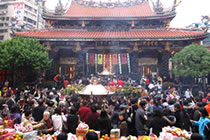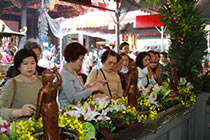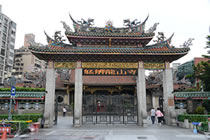THE INTRODUCTION OF LUNGSHAN TEMPLE
Lungshan Temple is located in the district Manka of Taipei. It was founded in 1738 and dedicated to the Buddhist Goddess of Mercy (Kuan-in in Chinese, or Avalokitesvara in Sanskrit).

This temple originated its name from the ancient Lungshan Temple established in Chin-chiang county of Fukien province in the seventh century.Immigrants from the three counties Chin-chiang, Nan-an and Hui-an of Fukien came to Manka in the beginning of the eighteenth century. As they were pious followers of that ancient Lungshan Temple in their home town, they erected this one as a branch temple at Manka and named it after the root temple when they created a new settlement here in Taipei. Lungshan Temple of today is no longer in the original buildings constructed in 1738. It was rebuilt in 1919 and completed in 1924.

Lungshan Temple always keeps it nature as a Buddhist temple,but in the course of its development many deities of Taoism were also included. The variety of deities in this temple shows the tolerant mentality of the Chinese people in their religious life.
The present Lungshan Temple consists of three halls: the fore hall, the main hall and the rear hall. The fore hall is used as the entrance and the space for the people to worship. The main hall is in the center of the whole complex with a statue of Kuan-in as the main god of the temple. Kuan-in is enshrined in the center accompanied by another two bodhisattvas, Manjusri at the left and Samantabhadra at the right. The eighteen Arhans are also present on both sides as attendants. When the temple was first established, it was only for the Buddhist deities as the main hall shows. The rear hall was added only around the end of the eighteenth century after Manka was assigned as an official port for the trade with Chuan-chou and Foochou of Fukien in 1792 by the chinese government. As a result of properous business, the merchant guild "Chuan Chiao" of Manka erected the rear hall to venerate their patron Matzu to pray for protection for their safe sailing to China on business. The rear hall is divided into three parts. The center is for the veneration of Matzu as the Goddess of marine voyage. The left is dedicated to the Gods of literature, or patrons of examinations for civil service in old days. The right is for the Lord Kuan, the God of war.

If an observer finds too numerous deities crowding in the rear hall, it is because of transfers. In the early years of this century when the government built new streets to reform the city, some temples were destroyed. The statues of the Gods of water and the city god of Tam-sui county were transferred to Lungshan Temple in the rear hall.
When they rebuilt Lungshan Temple in 1919, they employed Mr. Wang Yi-shun, a master of temple-building in southern Fukien, as the architect. This temple, therefore, has become a masterpiece of Mr. Wang's in Taiwan. He made it a beautiful temple in large scale decorated with fine stone and wood carvings. The front of the fore hall is covered with stone carvings. The arrangement of beige and dark green granites imported from China and black local andesites immediately gives visitors a beautiful impression of color combination at the first glance, not to mention the nicely carved relief and open works of these stones. The pair of dragon columns standing in front of the central door is cast with bronze. They are the only bronze columns in Taiwan. Two towers respectively for bell and drum are on the east and the west sides of the courtyard between the fore hall and the main hall. They are two-storied buildings with a conic roof in hexagonal shape like a helmet. Under it there skirts a second tier of roof. Each sector of this hexagonal roof in double eaves forms a slope in converse "S" curve. They are the first example of such a roof design introduced into Taiwan. Since the construction was in early part of this century, Mr. Wang already knew something about western architecture. He put small concrete gables on top of the front walls as decorative screens and added Corinthian capitals on some columns as ornaments. These characteristics together make Lungshan Temple a landmark of traditional Chinese architecture of its time in Taiwan.
It is well known that the statue of Kuan-in in this temple survived the bombing from the allied aircrafts on 8 June, 1945. Lungshan Temple was bombed on that day. The whole main hall and a part of the right annex were burned out during the air raid, but the statue of Kuan-in in the center of the main hall left intact. This is the most famous manifestation of efficacy of Lungshan Temple.
Being a masterpiece of traditional Chinese architecture and a well-established Buddhist temple in Taipei, the Lungshan Temple of Manka has become a center of people's religious life and a heritage of local culture. The government, therefore, assigned it a historical site of second grade on 19 August, 1985, so that it will be preserved for future generations.
